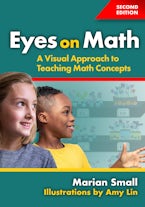Preface ix
Acknowledgments xiii
. Background
Visualization in Math
Focusing on the Important Math 3
Building Mathematical Communication 4
2. Grades K–2 7
Notice and Wonder
Strawberries 8
Egg Cartons
Bracelets 2
Daisies 4
Donuts
Explaining Concepts
Counting Up by s 8
Counting Back by s 2
Counting Up by 2s 22
Counting Back by 2s 24
Counting Up by 5s 2
Counting Back by 5s 28
Counting Up by s 3
Counting Back by s 32
Comparing Numbers by Matching 34
Benchmark Numbers: All About 5 3
Benchmark Numbers: All About 38
Ordinal Numbers 4
Addition as Combining 42
Adding and Adding 44
Addition: Commutativity 4
Addition: Changing Addends, But Not the Sum 48
Adding or Subtracting 5
Subtraction as Taking Away 52
Subtraction to Compare 54
Relating Addition and Subtraction 5
Naming Two-Digit Numbers 58
Naming Three-Digit Numbers
Place Value: Grouping in Tens 2
Place Value: Positions 4
Comparing Sizes of Numbers
Fractions: Halves 8
Fractions: Quarters 7
Measurement: Meaning of Length 72
Measurement: Effect of Unit Size 74
Measurement: Standard Units of Length 7
2-D Shapes Versus 3-D Shapes 78
Comparing 2-D Shapes 8
Comparing 3-D Shapes 82
Composing Shapes 84
Shape Puzzles 8
Student Assessment: Draw or Model to Explain
Rearranging Addends 89
Subitizing 8 9
Ordinal Numbers: Points of View 9
Subtracting by Adding 9
Nonstandard Measurement 92
3. Grades 3–5 95
Notice and Wonder
Quilts 9
Design 98
Juice
Tennis 2
Pastries 4
Explaining Concepts
Multiplication: Equal Groups
Multiplication: Commutativity 8
Multiplication: The Distributive Principle
Multiplication: 2-Digit by 2-Digit 2
Division as Equal Groups or Sharing 4
Division: Remainders
Rounding Numbers 8
Place Value: Multiplying and Dividing by Powers of 2
Place Value: Renaming Numbers 22
Factors: What They Are 24
Factors Come in Pairs 2
Fractions: Representing 28
Fractions: Equivalence 3
Fractions: Comparing 32
Fractions: Mixed Number/Improper Fraction Relationship 34
Fractions: Common Denominators 3
Adding Fractions 38
Multiplying Fractions 4
Fractions: Multiplying as Resizing 44
Fractions as Division 4
Decimals: Relating Hundredths to Tenths 48
Decimals: Equivalence 5
Decimals: Adding and Subtracting 52
Measurement: Time Intervals 54
Measurement: Area of Rectangles 5
Perimeter Versus Area 58
Measurement Conversions
Graphs With Scales 2
Coordinate Grids 4
Classification of Shapes
Parallel and Perpendicular Lines 8
Lines of Symmetry 7
Patterns Versus Nonpatterns 72
Algebraic Thinking: Growing Additively 74
Algebraic Thinking: Shrinking Additively 7
Algebraic Thinking: Growing Multiplicatively 78
Student Assessment: Draw or Model to Explain
Fractions of a Set 8
Fraction as Division 8
Relating Quotients 82
Comparing Products 83
Factors 84
4. Grades –8 87
Notice and Wonder
Roller Coasters 88
A Giant Burger 9
Going to a Concert 92
Basketball 94
A Solar Eclipse 9
Explaining Concepts
Common Factors 98
Common Multiples 2
Square Roots 2 2
Fraction Division 2 4
Ratios: Multiple Ratios Describe Any Situation 2
Equivalent Ratios 2 8
Equivalent Rates 2
Solving Rate Problems 2 2
Describing Percent 2 4
Uses of Integers 2
The Zero Principle 2 8
Subtraction of Integers as a Directed Distance 22
Multiplication and Division of Integers 222
Area of a Parallelogram 224
Area of a Triangle 22
The Pythagorean Theorem 23
Pi 232
How Measurements Are and Are Not Related 234
Mean 23
Variability 238
Sampling 24
Probability: What It Means 242
Unpredictability 244
Rotations, Reflections, and Translations 24
Scale Drawings 248
Dilations 25
Angles With Parallel Lines 252
Equivalent Expressions 254
Equation as a Balance 25
Different Types of Equations 258
What Is Linear? 2
Role of the Slope in the Equation of a Line 2 2
Systems of Equations 2 4
Function Rules 2
Student Assessment: Draw or Model to Explain
Subtracting Negatives 2 8
Relating Percents 2 9
Square Root Estimates 27
Dividing Fractions 272
Common Factors 273
Appendix: Connections Between Topics and Common Core Standards 275
References 279
Index 28
About the Authors 285

